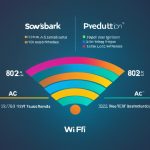Wi-Fi 6, also known as IEEE 802.11ax, is the latest wireless standard that brings a range of key features and benefits to enhance connectivity and performance in demanding Wi-Fi environments.
With higher data rates, increased capacity, improved power efficiency, and performance in environments with many connected devices, Wi-Fi 6 is designed to meet the growing demands of modern networks.
But what exactly are the key features and benefits of Wi-Fi 6? In this article, we will delve into the details, exploring how Wi-Fi 6 protocol revolutionizes wireless connectivity and empowers organizations to embrace the future of wireless communication.
Wi-Fi 6 and Wi-Fi 6E: Understanding the Differences
When it comes to next-generation wireless standards, Wi-Fi 6 and Wi-Fi 6E are often mentioned in the same breath. While they are related, it’s important to understand the key differences between the two.
Wi-Fi 6 operates in the 2.4 GHz and 5 GHz frequency bands, which are commonly used by previous Wi-Fi standards. On the other hand, Wi-Fi 6E takes advantage of the newly available 6 GHz band, expanding the spectrum for wireless communication.
One of the main advantages of Wi-Fi 6E is the additional channels and capacity it offers in the 6 GHz band. This allows for faster speeds and reduced congestion compared to Wi-Fi 6 devices, providing a better overall user experience.
Wi-Fi 6E also brings improvements in terms of speed, latency, and interference. With dedicated spectrum in the 6E band, devices can operate without interference from legacy Wi-Fi devices in the 2.4 GHz and 5 GHz bands.
Despite these differences, both Wi-Fi 6 and Wi-Fi 6E are backward compatible, meaning they can connect to Wi-Fi 4, 5, and 6 networks when necessary. This ensures that devices using older Wi-Fi standards can still benefit from the advancements of Wi-Fi 6 and Wi-Fi 6E.
Comparison of Wi-Fi 6 and Wi-Fi 6E
| Features | Wi-Fi 6 | Wi-Fi 6E |
|---|---|---|
| Frequency Bands | 2.4 GHz, 5 GHz | 2.4 GHz, 5 GHz, 6 GHz |
| Channels and Capacity | Limited | Additional channels and capacity in the 6 GHz band |
| Advantages | Improved performance in crowded environments | Faster speeds, reduced congestion, decreased interference |
| Backward Compatibility | Yes | Yes |
Understanding the differences between Wi-Fi 6 and Wi-Fi 6E is crucial for organizations and individuals looking to upgrade their wireless networks. Whether it’s improved performance in crowded environments or the advantages of faster speeds and reduced interference, both Wi-Fi 6 and Wi-Fi 6E bring significant advancements to the world of wireless connectivity.
The Key Benefits of Wi-Fi 6/6E
Wi-Fi 6/6E offers several key benefits for organizations. These include:
Increased AP Capacity
Wi-Fi 6/6E provides improved capacity for access points (APs), allowing for better performance in environments with multiple devices and high bandwidth applications. The enhanced AP capacity enables more devices to connect simultaneously without experiencing significant slowdowns or congestion. This benefit is particularly crucial in busy office spaces, conference venues, or public areas with a high volume of Wi-Fi users.
Greater Channel Width
Wi-Fi 6/6E supports wider channels compared to previous Wi-Fi standards. By increasing the channel width, Wi-Fi 6/6E enables higher speeds and improved coverage. This means faster internet browsing, smoother streaming, and quicker file transfers. The wider channels also help reduce latency and improve overall network performance in Wi-Fi congested areas.
Improved Bandwidth Sharing
Wi-Fi 6/6E incorporates advanced features like Orthogonal Frequency Division Multiple Access (OFDMA) and data scheduling. These features enhance bandwidth sharing, allowing the Wi-Fi network to allocate resources more efficiently. As a result, multiple devices can transmit and receive data simultaneously, leading to better network efficiency and reduced latency. Wi-Fi 6/6E helps deliver consistent performance even in crowded Wi-Fi environments where many devices are competing for bandwidth.
Wi-Fi Sleeping for Power Savings
One of the significant benefits of Wi-Fi 6/6E is the introduction of Wi-Fi sleeping. This feature allows devices to conserve power by adjusting their Wi-Fi connection activity based on usage. When devices are not actively transmitting or receiving data, they can enter a sleep state, reducing power consumption. Wi-Fi sleeping improves battery life for devices like smartphones, tablets, and Internet of Things (IoT) devices, prolonging their usability without frequent charging or battery replacements.
Backward Compatibility
Wi-Fi 6/6E ensures backward compatibility with older Wi-Fi standards. This means that devices equipped with Wi-Fi 6/6E can seamlessly connect to Wi-Fi networks supporting earlier standards, such as Wi-Fi 4 (802.11n) or Wi-Fi 5 (802.11ac). Backward compatibility allows organizations to upgrade their Wi-Fi infrastructure gradually, ensuring compatibility with existing devices while gaining the benefits of Wi-Fi 6/6E. It also provides flexibility for future-proofing the network as newer devices become Wi-Fi 6/6E compatible.
| Benefits | Wi-Fi 6/6E |
|---|---|
| Increased AP Capacity | ✓ |
| Greater Channel Width | ✓ |
| Improved Bandwidth Sharing | ✓ |
| Wi-Fi Sleeping for Power Savings | ✓ |
| Backward Compatibility | ✓ |
Adopting Wi-Fi 6/6E offers organizations the opportunity to leverage these benefits and optimize their wireless networks for better connectivity, improved performance, and enhanced user experiences.

Wi-Fi 6/6E Limitations and Challenges
While Wi-Fi 6/6E offers significant improvements over previous wireless standards, it does have limitations and challenges that organizations should be aware of. These limitations can impact communication, coverage, speed and performance, and the compatibility of unsupported devices.
Communication Issues
Despite the advancements in Wi-Fi 6/6E, it is important to note that it alone cannot solve all communication issues. In environments with poor coverage or interference from physical obstructions or other wireless devices, Wi-Fi 6/6E may still struggle to provide a reliable, seamless connection.
Coverage Limitations
The coverage area of Wi-Fi 6/6E networks can be influenced by the frequency bands in which they operate. While Wi-Fi 6 utilizes the 2.4 GHz and 5 GHz bands, Wi-Fi 6E expands into the 6 GHz band, offering additional channels for increased capacity and reduced congestion. However, the reach of Wi-Fi signals in these frequency bands is generally shorter than lower-frequency alternatives, potentially resulting in limited coverage in larger spaces or areas with multiple walls and obstacles.
Speed and Performance Factors
Although Wi-Fi 6/6E promises enhanced speeds and performance, it does not guarantee external improvements if other factors are at play. Internet service provider limitations, congested networks, or bottlenecks in data transmission can still impact the overall speed and performance experienced by users. Wi-Fi 6/6E can only optimize the local wireless network but cannot mitigate external limitations.
Unsupported Devices and Older Wi-Fi Standards
Adopting Wi-Fi 6/6E does not automatically enhance the functionality of unsupported devices or older Wi-Fi standards. While Wi-Fi 6/6E devices are backward compatible and can connect to older Wi-Fi networks, the full benefits of Wi-Fi 6/6E may not be realized if devices do not support these newer protocols.
Organizations should carefully consider these limitations and challenges when deciding whether to adopt Wi-Fi 6/6E. Conducting a thorough analysis of their specific communication needs, infrastructure requirements, and device compatibility can help make an informed decision.
The Wi-Fi 6 Specification and Nordic’s nRF70 Series
When it comes to Wi-Fi 6, there are specific technical specifications that define its capabilities and functionalities. One notable player in this field is Nordic’s nRF70 Series, which supports many of the features outlined in the Wi-Fi 6 specification.
Nordic’s nRF70 Series is designed to be compatible with the widely recognized IEEE standards, including 802.11 a/b/g/n/ac/ax. This compatibility ensures seamless integration with a wide range of Wi-Fi 6 devices and networks, allowing for efficient and reliable connectivity.
In terms of security, the nRF70 Series offers robust protection with support for various security protocols. These include WEP, WPA, WPA2-PSK, WPA2-PSK-SHA256, and WPA3-SAE, which help safeguard against unauthorized access and ensure the integrity of data transmitted over Wi-Fi networks.
When it comes to radio bands, the nRF70 Series supports both the 2.4 GHz and 5 GHz frequencies. This wide-ranging compatibility allows for flexibility in deployment, ensuring optimal performance in various environments.
The nRF70 Series also boasts impressive maximum PHY throughput of 86 Mbps, making it capable of handling demanding applications and data-intensive tasks effectively. Additionally, it offers a channel bandwidth of 20 MHz, further enhancing data transmission speeds.
Moreover, the nRF70 Series incorporates multi-user operation, enabling simultaneous connections by multiple devices, enhancing network capacity and reducing latency. It also features power-saving modes that contribute to improved energy efficiency and extended battery life for Wi-Fi 6-enabled devices.
Furthermore, the Nordic nRF70 Series excels in coexistence with other wireless technologies, such as Bluetooth LE, Thread, and Zigbee. This compatibility ensures seamless interoperability, empowering users to leverage diverse wireless connectivity options.
Overall, the Wi-Fi 6 specification offers a host of benefits for enhanced connectivity, and Nordic’s nRF70 Series excels in supporting and implementing these features effectively. With its compatibility with IEEE standards, support for multiple security protocols, presence in multiple radio bands, and various other capabilities, the nRF70 series proves to be a reliable and efficient solution for unlocking the full potential of Wi-Fi 6.
| Wi-Fi 6 Specification and Nordic’s nRF70 Series | Details |
|---|---|
| Compatibility with IEEE standards | 802.11 a/b/g/n/ac/ax |
| Supported security protocols | WEP, WPA, WPA2-PSK, WPA2-PSK-SHA256, WPA3-SAE |
| Supported radio bands | 2.4 GHz, 5 GHz |
| Maximum PHY throughput | 86 Mbps |
| Channel bandwidth | 20 MHz |
| Multi-user operation | Supported |
| Power-saving modes | Available |
| Co-existence with other wireless technologies | Bluetooth LE, Thread, Zigbee |
Conclusion
Wi-Fi 6 and Wi-Fi 6E are the latest wireless standards that offer significant benefits and improvements in connectivity and performance. With Wi-Fi 6, users can experience higher data rates, increased capacity, improved power efficiency, and enhanced performance even in crowded Wi-Fi environments with numerous connected devices.
Wi-Fi 6E builds upon the advantages of Wi-Fi 6 by operating in the 6 GHz band, which provides additional channels and reduced interference. This allows for even faster speeds, lower latency, and improved performance in Wi-Fi 6E devices. Organizations can benefit from greater network performance, support for more users, and the ability to explore new use cases such as unified communications and cloud computing.
However, it is important to acknowledge the limitations and challenges of Wi-Fi 6/6E. These include potential communication issues in environments with poor coverage or interference, as well as the inability of Wi-Fi 6/6E to guarantee external speed and performance improvements in the presence of other limiting factors. Compatibility with unsupported devices and older Wi-Fi standards should also be considered.
Despite the limitations, Wi-Fi 6 and Wi-Fi 6E are solid choices for organizations that want to enhance their wireless networks and meet the demands of modern connectivity. The key features, benefits, and advancements offered by Wi-Fi 6 and Wi-Fi 6E make them valuable options for improving wireless experiences and supporting the growing number of connected devices in today’s digital landscape.
FAQ
What is Wi-Fi 6?
Wi-Fi 6 is the latest wireless standard, also known as IEEE 802.11ax. It offers several key features and benefits that enhance connectivity and performance in demanding Wi-Fi environments.
What are the key features of Wi-Fi 6?
Wi-Fi 6 provides higher data rates, increased capacity, improved power efficiency, and performance in environments with many connected devices. It also extends into the 6 GHz band with Wi-Fi 6E, which offers additional channels and capacity.
How is Wi-Fi 6E different from Wi-Fi 6?
Wi-Fi 6 operates in the 2.4 GHz and 5 GHz frequency bands, while Wi-Fi 6E extends into the newly available 6 GHz band. Wi-Fi 6E devices can utilize additional channels and capacity in the 6 GHz band, enabling faster speeds and reduced congestion compared to Wi-Fi 6 devices.
What are the benefits of Wi-Fi 6/6E?
Wi-Fi 6/6E provides increased AP capacity, allowing for better performance in environments with multiple devices and high bandwidth applications. It also supports greater channel width, enabling higher speeds and improved coverage. Wi-Fi 6/6E improves bandwidth sharing, reduces latency, and offers Wi-Fi sleeping for power conservation. Additionally, it is backward compatible with older Wi-Fi standards.
What are the limitations and challenges of Wi-Fi 6/6E?
While Wi-Fi 6/6E offers significant improvements, it cannot solve all communication issues, especially in environments with poor coverage or interference. It also does not guarantee external speed and performance improvements if other factors are present, such as internet service provider limitations. Wi-Fi 6/6E may not improve the functionality of unsupported devices or older Wi-Fi standards.
What is the Wi-Fi 6 specification and Nordic’s nRF70 Series?
Wi-Fi 6 has specific technical specifications, and Nordic’s nRF70 Series supports many of these features. The nRF70 Series is compatible with IEEE standards, including 802.11 a/b/g/n/ac/ax. It supports various security protocols such as WEP, WPA, WPA2-PSK, WPA2-PSK-SHA256, and WPA3-SAE. The radio bands supported are 2.4 GHz and 5 GHz.



















